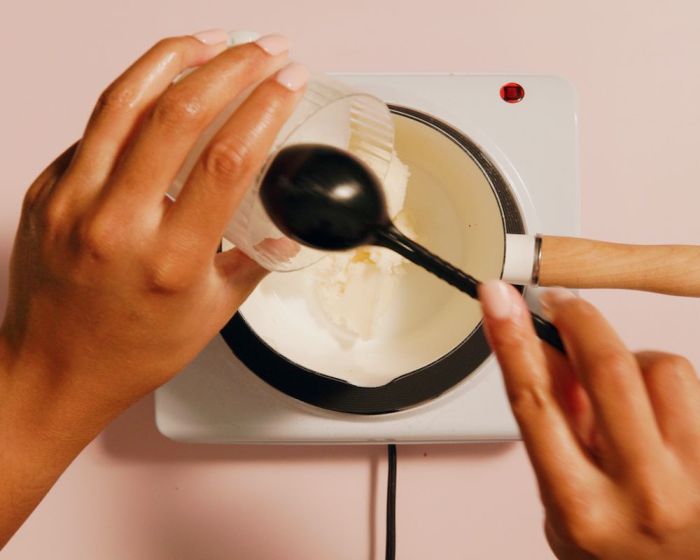DIY curl cream sets the stage for this enthralling narrative, offering readers a glimpse into a story that is rich in detail and brimming with originality from the outset.
Table of Contents
Have you ever dreamt of achieving bouncy, defined curls without relying on expensive salon products? DIY curl cream allows you to create your own customized hair care solution, tailored to your specific hair needs. This guide will take you through the process of crafting your own curl cream, from understanding the essential ingredients to mastering application techniques.
Benefits of DIY Curl Cream

Making your own curl cream can be a rewarding experience, allowing you to customize the product to your specific hair needs and potentially save money.
Cost Savings
Creating your own curl cream can significantly reduce your expenses. Commercial curl creams can be expensive, with prices ranging from $10 to $30 or more per bottle. By using readily available ingredients, you can create a comparable product at a fraction of the cost. For example, a simple DIY curl cream recipe using ingredients like aloe vera gel, coconut oil, and shea butter can be made for under $5, offering a substantial cost savings.
Natural Ingredients
DIY curl creams allow you to control the ingredients, opting for natural and organic options. Many commercial curl creams contain harsh chemicals, artificial fragrances, and silicones that can strip your hair of its natural oils, leading to dryness and damage. By using natural ingredients like aloe vera, honey, and essential oils, you can nourish your hair and scalp without the harmful effects of synthetic chemicals.
Customization
DIY curl creams provide the flexibility to customize the product to your hair’s unique needs. If your hair is prone to dryness, you can add more moisturizing ingredients like shea butter or avocado oil. For frizz control, you can incorporate ingredients like flaxseed gel or aloe vera. You can also experiment with different essential oils to achieve your desired scent and hair benefits.
DIY Curl Cream Storage and Shelf Life
Proper storage and shelf life are crucial for maintaining the effectiveness and safety of your homemade curl cream. Just like any other homemade beauty product, your DIY curl cream can spoil over time, so it’s essential to store it correctly and use it within a reasonable timeframe.
Storage Guidelines
Storing your DIY curl cream correctly will help prevent spoilage and maintain its effectiveness. Here are some guidelines:
- Store your DIY curl cream in an airtight container to prevent air and moisture from getting in. Air exposure can oxidize ingredients, leading to spoilage.
- Choose a container made of glass or food-grade plastic. Avoid using metal containers, as they can react with some ingredients.
- Store your DIY curl cream in a cool, dark place, away from direct sunlight and heat. Extreme temperatures can degrade ingredients and affect the consistency and effectiveness of your cream.
- Keep your DIY curl cream away from the bathroom sink, as the steam from hot showers can create a humid environment that promotes mold growth.
Shelf Life
The shelf life of your DIY curl cream depends on the ingredients used and the storage conditions. Generally, a homemade curl cream made with natural ingredients can last for 2-4 weeks if stored correctly. However, some ingredients, like essential oils, can have shorter shelf lives. Here are some tips for extending the shelf life of your DIY curl cream:
- Use a preservative like grapefruit seed extract or potassium sorbate. These ingredients help inhibit the growth of bacteria and mold, extending the shelf life of your cream.
- Consider using ingredients with longer shelf lives. For example, shea butter and coconut oil have longer shelf lives than aloe vera gel or avocado oil.
- Make small batches of your DIY curl cream to ensure that you use it up before it spoils.
Signs of Spoilage
It’s important to be able to identify the signs of a spoiled DIY curl cream. Here are some things to look for:
- Change in color: Your DIY curl cream may change color from its original shade. This could indicate that the ingredients are oxidizing or that bacteria are growing.
- Change in texture: Your DIY curl cream may become thinner or thicker, or it may develop a grainy texture. This could indicate that the ingredients are separating or that bacteria are growing.
- Change in smell: Your DIY curl cream may develop an unpleasant or sour odor. This is a strong indication that the cream has spoiled and should be discarded.
- Mold growth: If you see any visible mold growth on your DIY curl cream, discard it immediately. Mold can be harmful to your skin.
Safety Precautions: Diy Curl Cream

Making your own curl cream can be a fun and rewarding experience, but it’s important to prioritize safety throughout the process. Just like any other beauty product, a little precaution goes a long way in ensuring a positive experience.
Clean and Sanitized Tools, Diy curl cream
Cleanliness is crucial when making any beauty product, and DIY curl cream is no exception. Using clean and sanitized tools helps prevent contamination and reduces the risk of bacteria or other microorganisms growing in your product.
- Wash all tools, such as bowls, spoons, and whisks, with warm, soapy water and thoroughly rinse them.
- Sanitize tools by boiling them in water for a few minutes or by using a solution of 1 part bleach to 10 parts water.
- Allow tools to air dry completely before using them.
Avoiding Allergic Reactions
While many ingredients used in curl creams are generally safe, some individuals may have sensitivities or allergies. It’s important to be aware of potential allergens and take steps to minimize the risk of reactions.
- Always check the ingredient list of any product you use, even if you’ve used it before. Ingredients can change over time.
- If you have known allergies, avoid products containing those ingredients.
- Do a patch test before applying any new product to your entire scalp or hair. Apply a small amount to the inside of your elbow and wait 24 hours to see if you have any reaction.
- Start with a small amount of the product and gradually increase the amount if there’s no reaction.
Safe Storage and Handling
Proper storage and handling are essential for maintaining the quality and safety of your DIY curl cream.
- Store your curl cream in a clean, airtight container to prevent contamination and oxidation.
- Keep the container in a cool, dry place, away from direct sunlight and heat. Extreme temperatures can degrade the ingredients and affect the product’s efficacy.
- Label the container with the date it was made and the ingredients used. This helps you track the product’s shelf life and identify any potential allergens.
- Wash your hands thoroughly before and after handling the curl cream.
Embarking on the DIY curl cream journey allows you to embrace a natural approach to hair care, fostering a deeper connection with your hair and its unique needs. With a little creativity and experimentation, you can unlock the secret to achieving stunning, healthy curls, all while enjoying the satisfaction of crafting your own beauty solution.
DIY curl cream can be a fun and rewarding project, allowing you to customize your hair care routine to your specific needs. If you’re feeling ambitious, you could even try building your own DIY amp kit to power your hair dryer for a more efficient and personalized experience. Of course, if you’re just looking for a simple DIY project, focusing on a curl cream is a great place to start.

